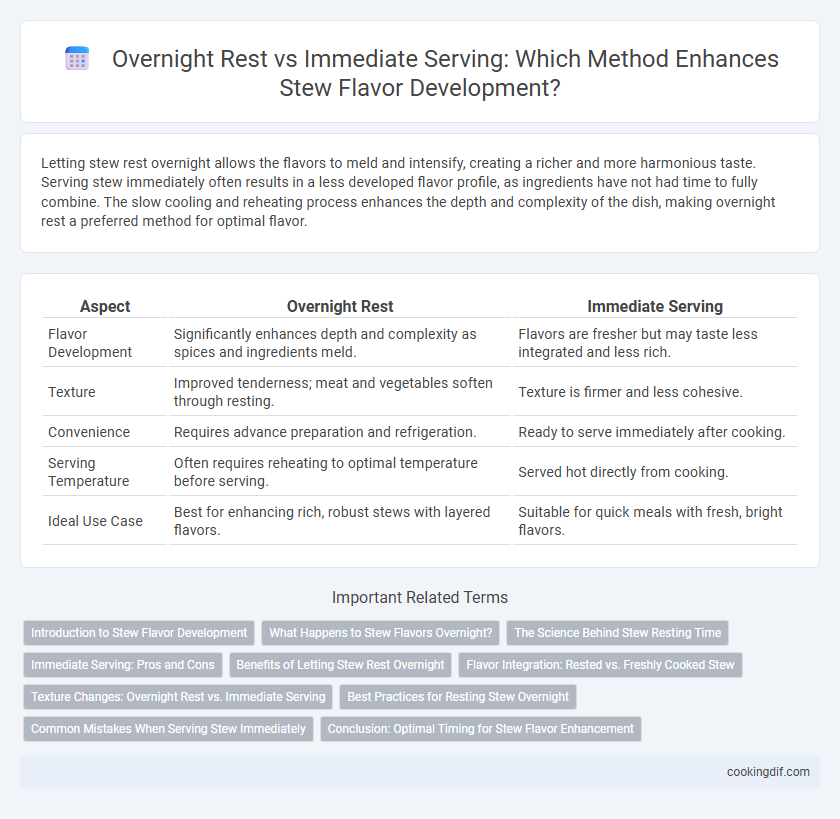Letting stew rest overnight allows the flavors to meld and intensify, creating a richer and more harmonious taste. Serving stew immediately often results in a less developed flavor profile, as ingredients have not had time to fully combine. The slow cooling and reheating process enhances the depth and complexity of the dish, making overnight rest a preferred method for optimal flavor.
Table of Comparison
| Aspect | Overnight Rest | Immediate Serving |
|---|---|---|
| Flavor Development | Significantly enhances depth and complexity as spices and ingredients meld. | Flavors are fresher but may taste less integrated and less rich. |
| Texture | Improved tenderness; meat and vegetables soften through resting. | Texture is firmer and less cohesive. |
| Convenience | Requires advance preparation and refrigeration. | Ready to serve immediately after cooking. |
| Serving Temperature | Often requires reheating to optimal temperature before serving. | Served hot directly from cooking. |
| Ideal Use Case | Best for enhancing rich, robust stews with layered flavors. | Suitable for quick meals with fresh, bright flavors. |
Introduction to Stew Flavor Development
Overnight rest in stew allows flavors to meld and deepen as ingredients continue to break down and infuse, enhancing richness and complexity more than immediate serving. Heat retained during resting promotes the absorption of spices and aromatics, resulting in a balanced and harmonious taste profile. Serving stew immediately, while convenient, often yields a fresher but less integrated flavor experience, as the full chemical reactions that build depth require time to develop.
What Happens to Stew Flavors Overnight?
Stew flavors intensify overnight as the ingredients continue to meld, allowing spices and herbs to penetrate the meat and vegetables more deeply. The resting process breaks down collagen and connective tissues, resulting in a richer, more tender texture and a harmonious taste profile. This slow flavor development enhances complexity, making the stew more savory and well-rounded compared to immediate serving.
The Science Behind Stew Resting Time
Allowing stew to rest overnight enhances flavor development through a process called flavor melding, where individual ingredients continue to release and absorb aromatic compounds, resulting in a richer, more balanced taste. During refrigeration, collagen in tougher cuts of meat further breaks down into gelatin, improving texture and mouthfeel. Immediate serving often lacks this depth as the ingredients' chemical interactions and enzymatic activities require time to fully develop complex, savory profiles.
Immediate Serving: Pros and Cons
Serving stew immediately preserves its fresh, vibrant flavors and offers a quicker meal solution, ideal for busy schedules. However, the spices and ingredients may not fully meld, resulting in less depth and complexity compared to stew that has rested overnight. Immediate serving can also lead to variations in texture, as some meats and vegetables may be less tender than after prolonged marinating or cooling.
Benefits of Letting Stew Rest Overnight
Allowing stew to rest overnight enhances flavor complexity as the ingredients fully meld, deepening savory notes and harmonizing spices. This resting period also tenderizes tougher cuts of meat, resulting in a richer texture and improved mouthfeel. The gradual cooling and reheating process intensifies umami, making the stew more satisfying and balanced compared to immediate serving.
Flavor Integration: Rested vs. Freshly Cooked Stew
Resting stew overnight allows flavors from herbs, spices, and ingredients to meld deeply, creating a richer, more balanced taste compared to freshly cooked. The extended time facilitates chemical reactions like Maillard and enzymatic processes that enhance amino acids and sugars, intensifying umami and overall complexity. Serving stew immediately may result in sharper, less harmonious flavors, while overnight rest promotes smoother consistency and fuller flavor integration.
Texture Changes: Overnight Rest vs. Immediate Serving
Allowing stew to rest overnight enhances flavor complexity as the ingredients meld, resulting in a richer taste profile. Texture changes occur as collagen breaks down further, producing tender, melt-in-the-mouth meat and softened vegetables. Immediate serving often yields firmer meat and less integrated flavors, making overnight rest essential for optimal stew texture and taste.
Best Practices for Resting Stew Overnight
Resting stew overnight enhances flavor development by allowing spices and ingredients to meld more thoroughly, resulting in a richer, more balanced taste. Best practices include cooling the stew quickly to prevent bacterial growth, storing it in an airtight container in the refrigerator at or below 40degF, and reheating gently to preserve texture. This process optimizes nutrient retention and deepens the complexity of the dish compared to immediate serving.
Common Mistakes When Serving Stew Immediately
Serving stew immediately after cooking often results in underdeveloped flavors and a watery texture, as the ingredients have not had sufficient time to meld. Common mistakes include skipping the resting period that allows collagen breakdown and spice infusion, leading to a less rich and complex taste profile. Properly resting stew overnight enhances the depth of flavor and improves tenderness, creating a more satisfying dining experience.
Conclusion: Optimal Timing for Stew Flavor Enhancement
Allowing stew to rest overnight significantly enhances flavor depth and complexity by enabling the ingredients to meld and the spices to intensify. Immediate serving often results in a less developed taste profile, with flavors remaining distinct rather than fully integrated. For optimal flavor enhancement, refrigerate the stew overnight to achieve a richer, more harmonious taste experience.
Overnight Rest vs Immediate Serving for Flavor Development Infographic

 cookingdif.com
cookingdif.com